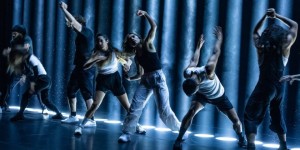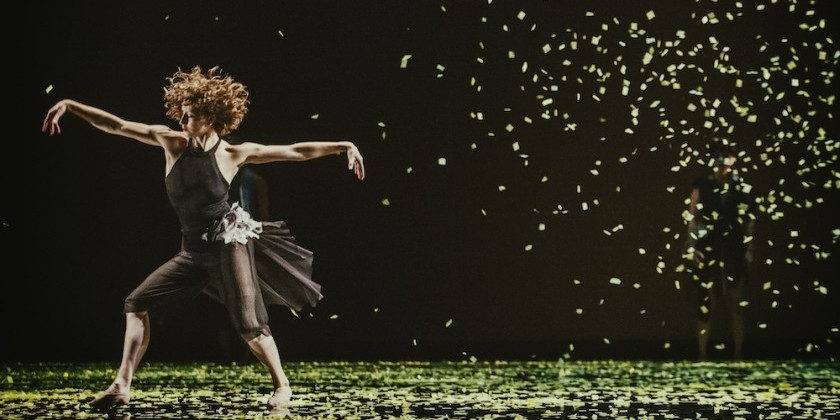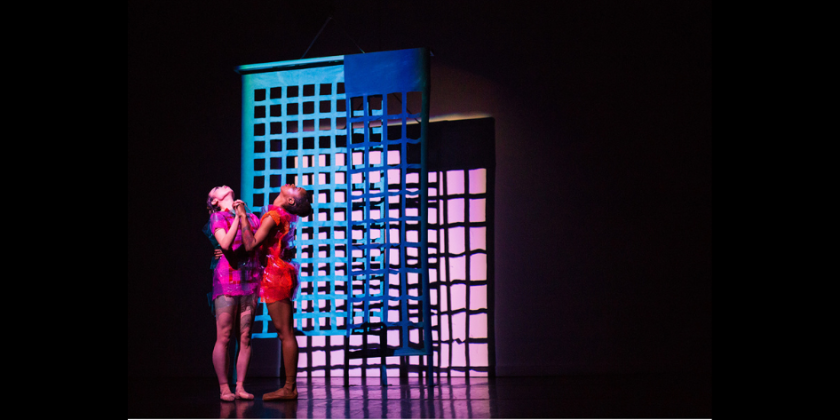IMPRESSIONS: ODC/Dance's "boulders and bones" with Zoë Keating at BAM

October 26th, 2017
Choreographers: Brenda Way and KT Nelson
Performers: Jeremy Smith, Natasha Adorlee Johnson, Josie G. Sadan, Brandon Freeman, Jeremy Bannon-Neches, Tegan Schwab, Daniel Santos, Rachel Furst, Lani Yamanaka, James Gilmer
Commissioned score: Zoe Keating
Cello performance: Zoe Keating
Video: RJ Muna
Lighting and Scenic Design: Alexander V. Nichols
Landscape Artist: Andy Goldsworthy
Brooklyn Academy of Music’s Next Wave Festival, inaugurated in 1986, acts as a comprehensive guide to what’s new and hot in music, theater, opera, and dance. The 2017 festival presents San Francisco’s ODC/Dance at BAM Harvey. boulders and bones, choreographed in 2014 by Brenda Way and KT Nelson, meditates on the landscape of Northern California. While sometimes this theme gets lost in the extravagant elements, the piece offers intense stimulation.
Founded in Oberlin in 1971 before relocating to San Francisco in 1976, ODC/Dance is one of the first American companies to combine contemporary ballet with post-modern ideas. Choreographers Way and Nelson find great inspiration in modern life, and boulders and bones juxtaposes the inherent impermanence of humanity with nature.
boulders and bones is directly inspired by Culvert Cairn, a stone installation by Andy Goldsworthy that highlights and responds to the dynamics of Marin County’s geography: still, dry summers and wild, rainy winters.

Culvert Cairn appears as a hollow circle of rocks; the inside contains an assemblage of rocks shaped like a three-dimensional teardrop. Alexander Nichols’ scenic design mimics these contours. In place of the stone teardrop is a stage, upon which cellist and composer Zoë Keating is mounted, a globular frame encircling her. Keating’s bubble starts contained within the cairn, but throughout the piece, it gets wheeled around to different parts of the stage.
In the first movement of the piece, the cast relates the construction process of Culvert Cairn, using props as well as their own bodies to create structures. Two dancers crouch around a pile of sticks. As the lights dim, the couple deliberately places the sticks on top of one another to create a fragile structure, which eventually gets demolished. Behind them, a time-lapse video of the construction process of Culvert Cairn is projected. Later, it is lifted to reveal the rest of the cast.
This movement swells with energy. A leggy duet between Josie G. Sadan and Jeremy Smith creatively twists traditional ballet partnering. Sadan slides her chin down Smith’s outstretched arm while slowly falling towards him.
Natasha Johnson is the troublemaker. As the rest of the cast stands frozen in a one-legged balance, she whirls behind them, plowing into a dancer on stage left. One by one, she manipulates them until the entire line has come to life.

The activity onstage is constant, occasionally overwhelmingly so. Sometimes, a duet is paired against a trio while, other times, all ten dancers perform different movements simultaneously. At a climactic moment, a handful of dust is thrown in the air, its dry scent infiltrating the theater.
Mellow and meditative, the second movement shows the cast as shadowy figures in Nichols’ dim lighting. They sweep clean the dust from the stage as Keating is slowly wheeled around the space, playing her score where melodic lines loop on top of one another. Accumulating, these loops create a complex layered effect, similar perhaps to the building of Culvert Cairn.
In the third movement, an intricate plot unravels, singling out the tall, lovely Sadan, whose red costume differentiates her from the white-clad others. While the narrative is unclear, the work offers stunning imagery.
Two men hoist Sadan above their heads, and she examines her outstretched hands, slowly rotating them. This open-palmed gesture becomes thematic later in her lengthy solo, the first time that one dancer is present on stage. Here, she performs it with a wide first-position grand plié, an offering gesture of sorts.
Sadan holds a penché arabesque for an astonishing amount of time as the rest of the cast rushes in, surrounding her. The men hold the women underneath their arms and twirl them vigorously across the space, their billowy white skirts puffing out like foam on a churning ocean. The piece comes to a startling close when Smith sneaks behind her, angrily hurling a pile of red dust in the air — perhaps a warning of the dangers of meddling with nature?
In the case of boulders and bones, the impermanence inherent in both nature and human existence translates well to an art form as ephemeral as dance. Like barren land after a wildfire has ravaged through it, nothing remains at the close but our lingering memory of the dramatic, tumultuous performance.
The Dance Enthusiast Shares IMPRESSIONS/ our brand of review and Creates Conversation.
For more IMPRESSIONS, click here. For a Q+A with Co-Artistic Director Brenda Way, click here.
Share your #AudienceReview of this show or others for a chance to win a prize.













